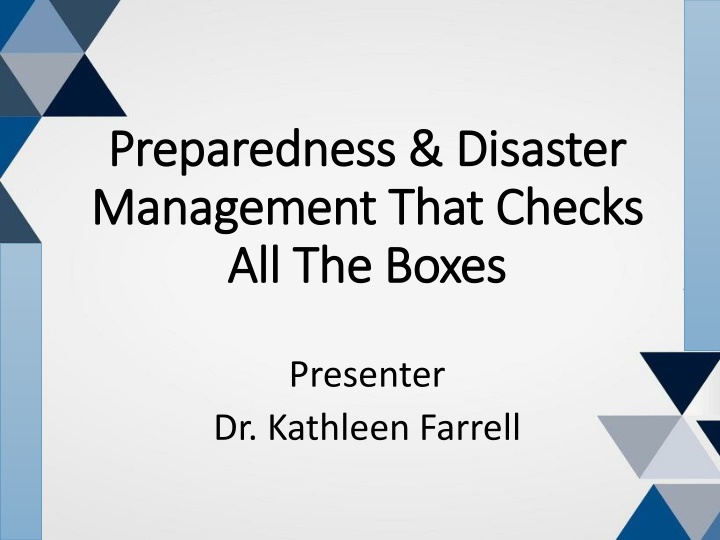
Disaster Preparedness and Management Best Practices
Explore the comprehensive guide on disaster preparedness and management that covers key aspects, definitions, benefits, core elements, and strategies presented by Dr. Kathleen Farrell. Gain insights on proactive measures, risk assessment, communication planning, and essential tools for effective disaster response.
Download Presentation

Please find below an Image/Link to download the presentation.
The content on the website is provided AS IS for your information and personal use only. It may not be sold, licensed, or shared on other websites without obtaining consent from the author. If you encounter any issues during the download, it is possible that the publisher has removed the file from their server.
You are allowed to download the files provided on this website for personal or commercial use, subject to the condition that they are used lawfully. All files are the property of their respective owners.
The content on the website is provided AS IS for your information and personal use only. It may not be sold, licensed, or shared on other websites without obtaining consent from the author.
E N D
Presentation Transcript
Preparedness & Disaster Preparedness & Disaster Management That Checks Management That Checks All The Boxes All The Boxes Presenter Dr. Kathleen Farrell
Preparedness & Disaster Management Preparedness & Disaster Management That Checks All The Boxes That Checks All The Boxes At the end of the presentation participants will be able to: Define preparedness and disaster management. State the importance of preparing for a disaster and its management. Plan key aspects of preparedness and disaster management.
Preparedness & Disaster Management That Checks All The Boxes Definition A disaster is an emergency that, due to its complexity, scope, or duration, threatens the organization s capabilities and requires outside assistance to sustain patient care, safety, or security functions.
Disaster Preparedness Definition Proactive measures and plans put in place by individuals, communities, and organizations to minimize the impact of natural or artificial disasters.
Benefits of Preparedness Minimize risk related to a disaster Support safety for employees and patients Safeguard (PHI) Protected Health Information Help define recovery efforts
Core Elements of Preparedness Risk assessment and Emergency Planning Determine which hazards are most likely to occur in your local area. Communication Plan Establish a system to connect with staff, providers, key contacts. Coordinate with regulatory agencies. Policies and Procedures Develop policies to guide the organization s plan that comply with regulations. Training and Testing Create a training program for employees
Key Aspects of Preparedness Strategies and Processes Hospitals need effective strategies and processes to assess, treat, and manage patients during emergencies. Tools Equipping hospitals with appropriate tools is crucial to managing patient overflow and various degrees of infection. Healthcare Workers Training, protective equipment, and access to communication net works are vital for their safety.
Key Aspects of Preparedness Safety of Patients Disaster preparation ensures patient safety, minimizes further harm, and improves health care delivery. Resource Management Comprehensive plans help hospitals to manage and allocate resources. Ex., medical supplies, equipment, staff. Collaboration Working with emergency agencies and stakeholders for a coordinated response and the pooling of resources.
Types of Disasters External Events Transportation Accidents Fire Health Issues Weather Food Safety Terrorism Nuclear Explosion
Types of Disasters Internal Events Technological Artificial Leadership and Decision Making Triage and Patient Management Fire Damage to Facilities & Services
Disaster Management Who can activate the disaster protocol? Chief Executive Officer Hospital Administrator Chief Operations Officer Director of Public Safety Head of Hospital Police
Disaster Management MITIGATION Aims to minimize the loss of human life that would result from a disaster. Measures that do the following: Prevent an emergency or reduce the chance of an emergency happening Reduce the damage and effects of the disaster
Disaster Management PREPAREDNESS An on going process in which businesses, organizations, institutions and community entities can plan, train, and prepare for how to manage a disaster. Develop policies and procedures Stocking supplies Drills & scenarios with staff, community and government agencies Identifying possible risk in the community
Disaster Management RESPONSE Actions carried out immediately before, during, and immediately after a hazard impact which is aimed at the following: saving lives, reducing economic loss, alleviating suffering. Activate the Command Center, Disaster Plan, Inform Staff Evacuating buildings & threatened populations Provide emergency rescue and medical care Opening shelters Coordinate efforts with Emergency Services, also Government and private agencies
Disaster Management RECOVERY Actions taken to return to normal/new normal conditions. Hospital/Institution Patient Care Admissions Review/Revisions of current disaster protocol Restocking Debriefing Caring for the staff
Disaster Management RECOVERY 4 C s of Disaster Recovery Communication Coordination Continuity Collaboration
References Khirekar, J., Badge, A., Gulshan R. B., Bandre, G. R., et al 2023) Disaster preparedness in hospitals. Cureus 15 (12):e50073. doi10.7759/cureus.50073 Puryear, B., Gungnoli, D. (2023). Emergency preparedness StatPearls NCBI Bookshelf. Retrieved May 12, 2024 from https:www.ncbi.nim.nih.gov/books/NBK537042/?report=printable Steps of emergency management. Retrieved May 12, 2023 from Https://mdem.Maryland.gov/Pages/10-Things.aspx The Centers for medicare & medicaid Services: Disaster planning for healthcare-4 core cms elements and more. Retrieved May 12, 2024 from https://www.greenwayhealth.com/knowledge-center/greenway-blog/4-key- elements-disaster-planning-healthcare The disaster management cycle:5 Key stages ucf online. Retrieved May 12, 2024 from Https://www.ucf.edu/online/leadership-management/news/the - disaster- management-cycle/#:
